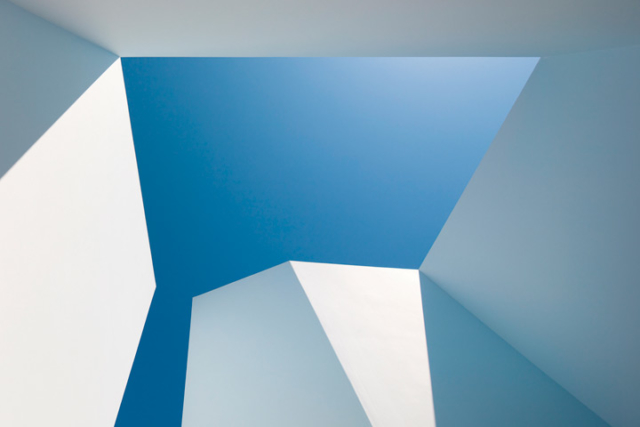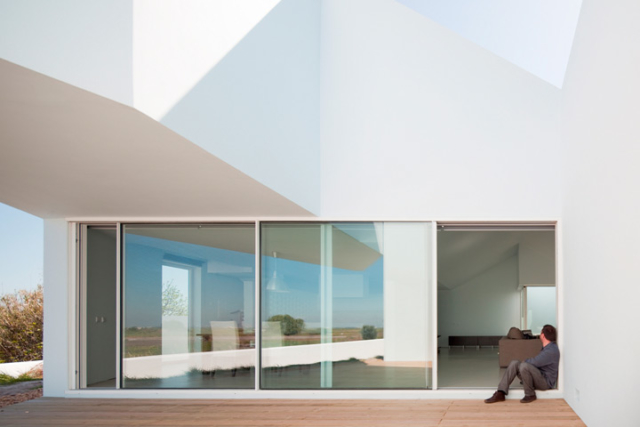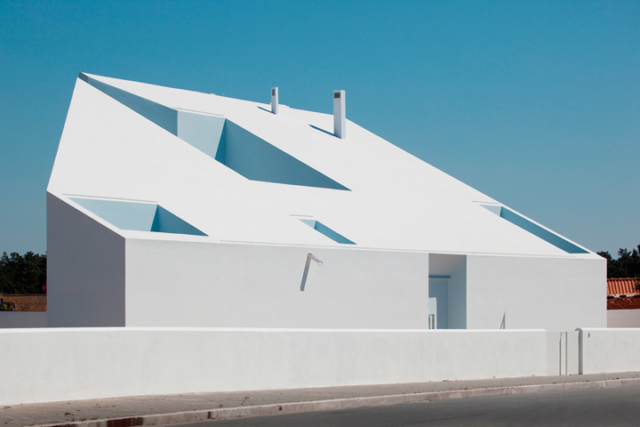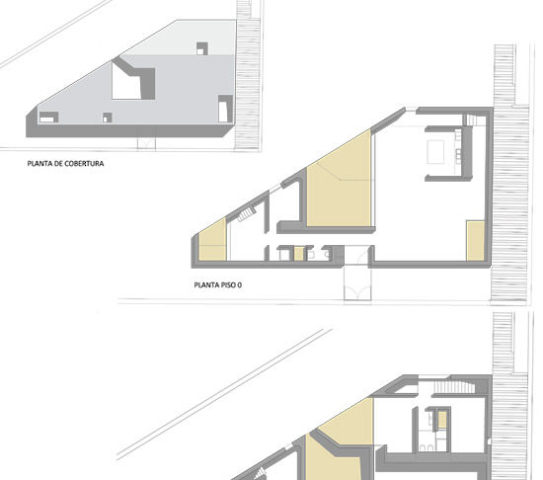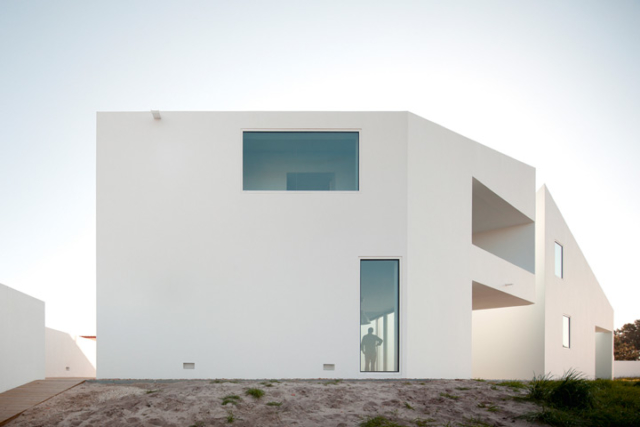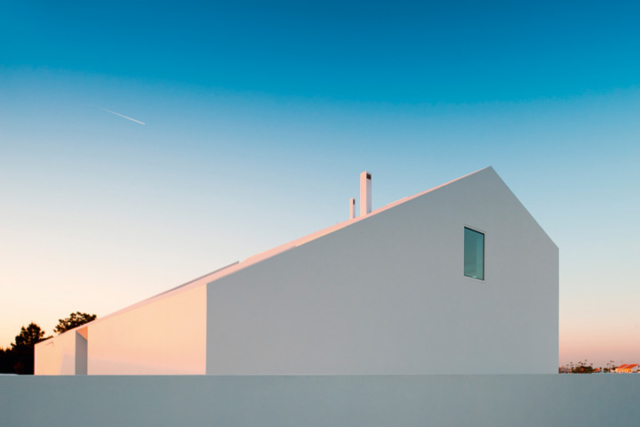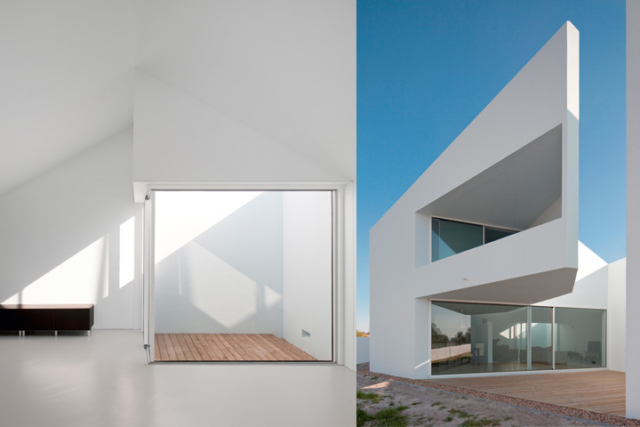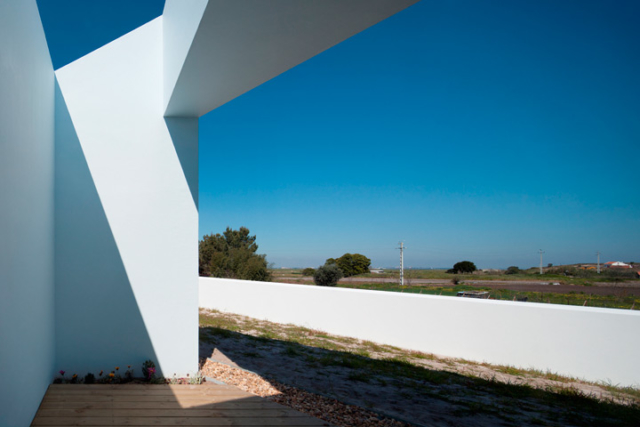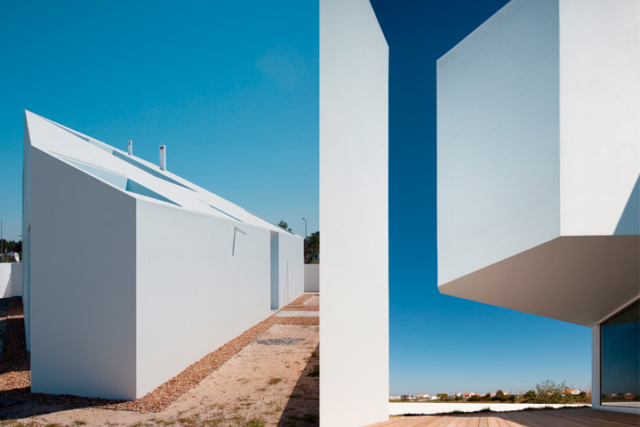Possanco, Alcácer do Sal, Portugal
Projekat: 2006 – 07
Izgradnja: 2008 – 09
Autori:
ARX PORTUGAL, Arquitectos Lda.
José Mateus, Nuno Mateus u saradni sa Stefano Riva
Projektantski tim:
Stefano Riva, Paulo Rocha
Fotografije:
FG+SG – Fotografia de Arquitectura
ARX Portugal Arquitectos
Bruto izgrađenost: 250 m2
Kulturno sastajalište koje spaja vlasnike kuća i arhitekte zasnovano je na njihovom zajedničkom interesu: nesumnjivo moderna arhitektura , ali ona čija bi priroda i konačni izraz takođe bili proizvod istraživanja primera tradicionalne arhitekture regiona Alentežu.
Teren za postavljanje ove male kuće u selu Posanko predstavlja prelaznu oblast između novog urbanog pojasa i zaštićene poljoprivredne zone. Prostrana severna ravnica završava se daleko u raskošnim Arabida planinama. Razbacane vodene niti reke Sado i Atlanski okean definišu horizont, kompletirajući ovaj slikoviti scenarijo.
Vlasnici su želeli malu vikendicu koja će im pružiti opušteno uživanje vikendom, nakon bekstva iz stresnog života u gradu. Naši umovi su dugo bili okupirani slikama takozvanog narodnog graditeljstva nastalog pre tehnološke ere, koje karakterišu male kuće sa ponekad asimetričnim krovovima, sa jednom od dve krovne ravni koja je duža u odnosu na drugu, tako da kuća izgleda disproporcionalno. Ovi dugački krovovi povećavaju udobnost tokom leta ali i tokom umereno hladnih zima. Prisustvo ovakvog tipa kuća u ravnici Alenteža sa fasadama okrečenim u belo ističu gotovo apstraktni oblik, stvarajući portret jedinstvene i izuzetne lepote.
Prvo relevantno ograničenje je trouglasti oblik male parcele koji, kada se primene zakonske regulative, gotovo ne dozvoljava nikakve formalne alternative. Razumevanje gradnje ovih kuća opet nailazi na paradoks: najinteresantniji pogled je okrenut ka severu umesto ka jugu gde bi trebali da budu smešteni prozori zbog boljeg prodora dnevne svetlosti. Na južnoj strani su ulica, saobraćaj i prolaznici čije poglede ka kući su vlasnici želeli da izbegnu. Ova dva aspekta činila su ključne karakteristike projekta, a u rešenje je uključen još jedan element iz tradicionalne arhitekture- atrijum.
U projektu je veličina određena regulacionim udaljenostima. Sa bočne strane, maksimalna dozvoljena visina je dostignuta zadnjim zidom (dva sprata), a prednji zid, okrenut ulici, ima minimalnu moguću visinu (jedan sprat). Prolazniku, kuća je rezultat deformisane perspektive, u aksonometrijskoj projekciji.
U nameri da se dobije prirodno svetlo sa juga, projektovana su četiri atrijuma: jedan centralni, jedan u dnevnoj sobi, jedan ispred toaleta i jedan u blizini dečje sobe.
Sa prozora koji su gotovo svi okrenuti severu, pruža se predivan pogled.
Istraživana je dominacija belog bloka i njegova apstraktna jedinstvenost.
Celokupan objekat bi bio beo, uključujući krov, dok bi atrijumi podsećali na nebo-plavu površinu, delikatno naglašavajući jak karakter kuće. U stvari, kuća je napravljena gotovo u potpunosti u skladu sa arhitekturom Alenteža: beli malter, svetlo/senka, debljina/masa, tekstura.
Unutar objekta, sobe se nalaze između dve ravni krova, a varijacije u obimu i dubini transformišu atmosferu svake prostorije. U sredini dnevne sobe je kuhinja koja preuzima drevnu ulogu ognjišta kao centralne tačke doma oko koje je sve ostalo koncentrisano.
Possanco, Alcácer do Sal, Portugal
Project: 2006 – 07
Construction: 2008 – 09
Architecture:
ARX PORTUGAL, Arquitectos Lda.
José Mateus, Nuno Mateus with Stefano Riva
Project Team:
Stefano Riva, Paulo Rocha
Photography:
FG+SG – Fotografia de Arquitectura
ARX Portugal Arquitectos
Gross Construction Surface: 250 m2
The cultural meeting point joining the house owners and the architects was based on their common interest: an undoubtedly contemporary architecture, but one whose nature and final expression would also be the outcome of a research of the paradigms figuring in the traditional architecture of the region, the Alentejo.
The implantation terrain of this small house, located in the village of Possanco, sets the transition area between the new urban strip and the protected agriculture zone. An extensive northbound plain ends far away at the splendid Arrabida mountain ridge. Sparse water spots of the river Sado spreading, and the Atlantic Ocean defining the horizon complete this scenario of a bold pictorial expression.
The owners wanted a small vacation house that allowed a casual and relaxed enjoyment of their weekend when escaping the urban everyday stress.
Our minds were for so long populated by images of the so-called popular architecture, produced before the technological era. They are small houses with sometimes asymmetric roofs, with one of the two garrets longer, almost disproportionate, reinforcing the compact aspect of volumes very much committed to the land where they are built. These long roofs make the houses cosy during the extremely hot summers and yet sober in the winter. The presence of these houses on the Alentejo plains, allied to the whiteness of their lime painting bringing out an almost abstract figure, compose portraits of a singular and surprising beauty.
The first relevant constraint is the triangular shape of the small lot which, when applying the legal distance measures, almost does not allow any formal alternatives. Conceiving the house had still to face a paradox: the most interesting views stand to the north and not south, where the windows should be placed in their quest for light. At south there is the street, traffic and passers-by whose look inside the house owners wanted to avoid.
These two aspects ended up being the key-features of the project and the solution would end being the introduction of yet another paradigm in traditional architecture: the patio
The volume is determined in blueprint by the regulated distances. In profile, the maximum height permitted is reached by the back wall (2 floors) and the front wall, facing the street, stays with the minimum height possible (1 floor). To the passer-by, the result is a house of deformed perspective, in axonometric projection.
In order to receive natural light to the south, we introduced in that long plan 4 patios: a central one, one in the living-room, one in the social toillets and a final one near the children’s room.
Almost all situated north, the windows guide the views to the amazing landscape. We explored the expressiveness of the white block and its abstract personality.
The totality of the volume would be white, roofs included, where the patios resemble bluish excavations, enhancing delicately the strong character of the house. In fact, the building is done almost exclusively with the Alentejo repertoire: white matter, light-shade, thickness/mass, texture.
Indoors, rooms occur in between “suggestions” of the traditional two-garret volume, and variations in scale and depth transform in each chamber the atmosphere of that inner world intentionally sober. In the middle of the living-room, the kitchen-island takes on the ancient role of the fire as a centre-piece of the home, around which everything comes to place.



